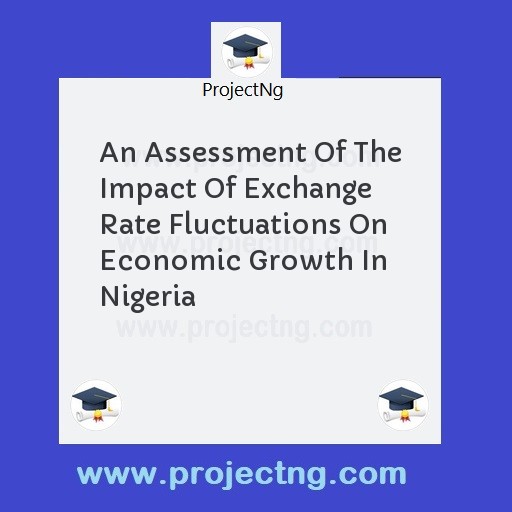An Assessment Of The Impact Of Exchange Rate Fluctuations On Economic Growth In Nigeria
Insurance Project Topics
Get the Complete Project Materials Now! »
AN ASSESSMENT OF THE IMPACT OF EXCHANGE RATE FLUCTUATIONS ON ECONOMIC GROWTH IN NIGERIA
ABSTRACT
This study investigates on “An assessment of the impact of exchange rate fluctuations on economic growth in Nigeria”. The researcher uses multi-regression analysis to capture his result, by applying ordinary least square (OLS) techniques. The dependent variable Real Exchange rate (RER) was captured by independent variables which include; Real Gross Domestic Product (RGDP), Real Interest Rate (RINT), Trade Openness (TON), Real Money Supply (RMS) and Inflation Rate (INF). From the Hypothesis stated in chapter one, “That Exchange Rate fluctuations have impact on economic growth. Analysis of OLS, showed that independent variables used confirm to the apriori expectations except Real Gross Domestic Product and Inflation. Also, from the results obtained showed that exchange rate fluctuations in Nigeria can be brought about by trade openness, Real money supply, Real interest rate, but Real Gross Domestic Product and inflation has no effect in Exchange rate fluctuations in Nigeria Economic growth, and this may be as a result of inadequacy in data used or human factor. Based on the findings, the researcher put forward the following recommendations: (i) The application of demand management and expenditure switching policies that should stabilize macroeconomic aggregates including exchange rates and improve the growth performance of the economy. (ii) The protection of domestic industries using appropriate trade policies is important in order to make domestic goods more competitive in the international market. (iii) Government should provide adequate incentives to domestic producers in the form of tax reduction and other subsides, which would reduce production costs and the prices of domestic goods. Thus making them more attractive globally.
TABLE OF CONTENTS
Title page
Approval page
Dedication
Acknowledgement
Abstract
Table of contents
CHAPTER ONE
1.0 Introduction
1.1 Background of the Study
1.2 Statement of the Problem
1.3 Objectives of the Study
1.4 Hypothesis of the Study
1.5 Significance of the Study
1.6 Limitation of the Study
CHAPTER TWO
2.0 LItertaure Review
2.1 Theoretical Literature
2.1.1The Mint Parity Theory
2.1.2The Purchasing Power Parity Theory (PPP)
2.1.3The Balance of Payment Theory
2.1.4The Traditional Flow Model
2.1.5The Portfolio Balance Model
2.1.6The Monetary Approach
2.1.7Mundell-Flemming Model
2.1.8The Dornbush Model
2.2 Sources of Variation in Exchange Rate
2.3 How Exchange Rates have been Determined
2.4 Exchange Rate Policies and Macroeconomic aggregates
2.5 Exchange Rate Depreciation and Inflation
2.6 Exchange Rate and balance of Payments
2.7 Exchange Rate and Investment
2.8 Empirical Literature
CHAPTER THREE
3.0 Methodology
3.1 Model Specifications
3.2 Method of Evaluation
3.3 Data Required and Sources
CHAPTER FOUR
4.0 Data Presentation and Analysis of Empirical Results
4.1 The Empirical Results
4.2 Examination of the Algebraic Signs of the Parameter Estimates
4.3 Statistical Test of Significance
4.4 Evaluation of the Working Hypothesis
4.5 Econometric Test
4.6 Implications of the Results
CHAPTER FIVE
5.0 Summary, Conclusion and Policy Recommendations
5.1 Summary of the Findings
5.2 Conclusion
5.3 Policy Recommendations
References
Appendix
CHAPTER ONE
1.0 INTRODUCTION
1.1 BACKGROUND OF THE STUDY
Globalization is soaring by the day since the end of the World War II. According to Samuelson (2002), “Most of the world economies have been enjoying growing economic cooperation, widening trade linkages, increasing integrated financial market and rapid economic growth”. We are therefore faced with the stark reality that no nation is an Island unto herself.
International trade provides the important economic links among nations. Thus, as nations trade with other nations, there is exchange of currencies since every country uses a unique currency for domestic transactions.
An exchange rate means the price of one currency in terms of another. It is the rate at which one currency is exchanged for the other (Anyanwokoro, 1999:109). A fall in exchange rate denotes depreciation while a rise signifies appreciation. As domestic currency depreciates, that of the foreign appreciates and vice-versa.
However, this study focuses only on the appreciation and depreciation of the naira vis-à-vis the U.S Dollar.
Therefore, exchange rate is an important macroeconomic variable which every government looks up to as they push for macroeconomic stability and economic progress.
The historical statistics surrounding the Nigeria exchange rate vis-à-vis the U.S Dollar obtained from the Central Bank of Nigeria (CBN) statistical Bulletin (2005) showed that the exchange rate was 0.72 = US 1.00 in 1970 and appreciated therefore until 1980 when N0.55 was exchanged per US dollar. A turning point was made hence forth as the exchange rate began to depreciate from 1980 to 2005. During this paid; N061, N0.02 and N7.39 per dollar were exchanged in 1981, 1986 and 1989 respectively. The trend kept on, as N8.03, N17.29 and N22.05 were exchanged per US dollar in 1990, 1992 and 1993 respectively. The new
Be the First to Share On Social

Enjoying our content?
Don't miss out on new videos! Subscribe to our YouTube channel for more awesome content.
Subscribe Now!













